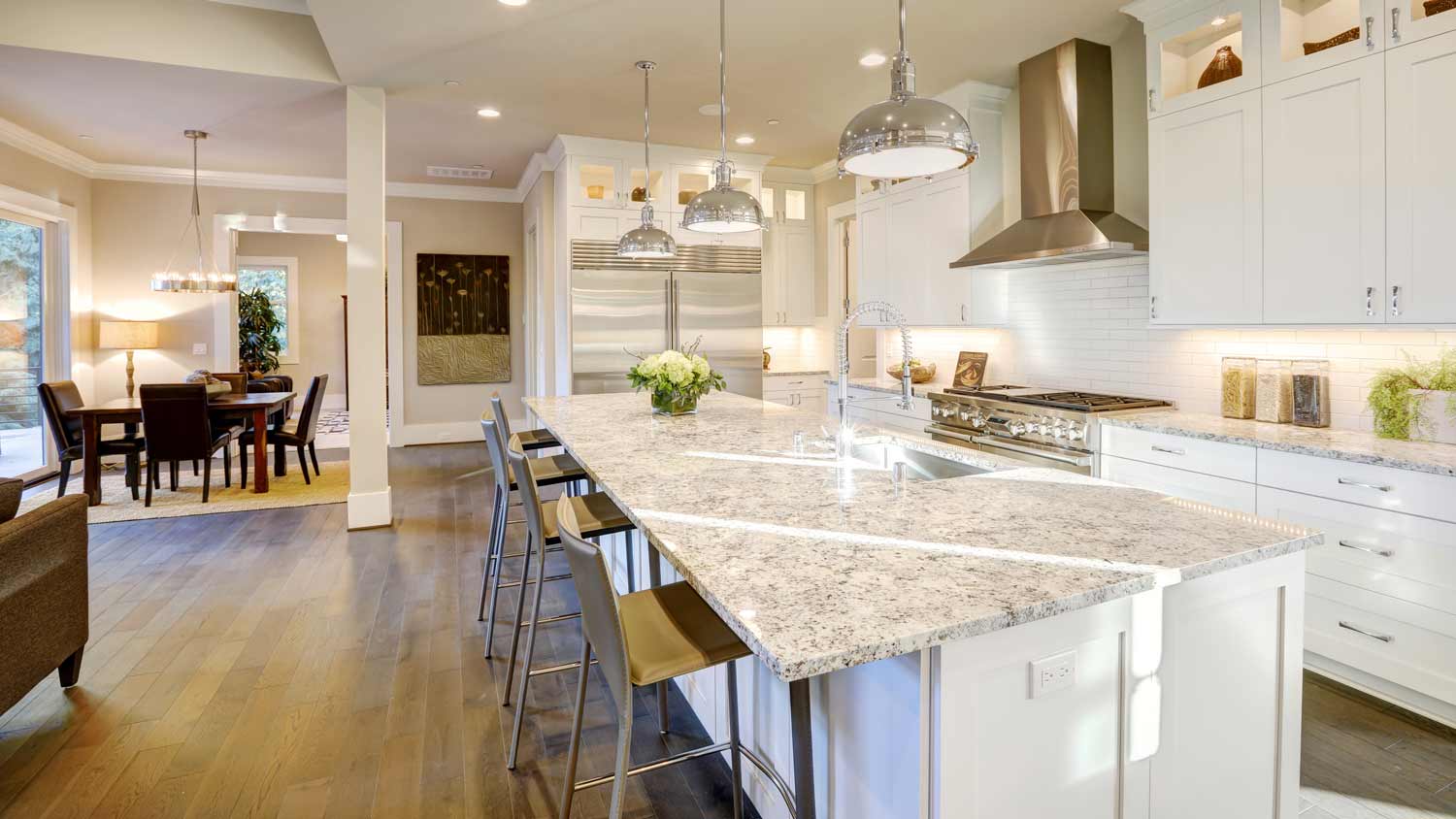Where To Place Recessed Lights in the Kitchen: What the Pros Say
Shine a light (or two) on your cooking


Place recessed lights around the kitchen perimeter or in parallel lines.
Use four to six lights per 10 x 10-foot room or every 100 square feet.
Space recessed lights 12 to 18 inches away from the walls.
Space recessed lights 36 to 48 inches apart.
Did you know you can make your kitchen feel new just by installing recessed lighting? With purposeful planning, recessed lighting can illuminate focal points, eliminate shadows, and add ambiance to any room. We've put together some information to help shine a light on where to place recessed lights in the kitchen.
What Is Recessed Lighting?
You may be wondering what recessed lighting is. As the name suggests, recessed lights are subtle lights you’ll see on ceilings and walls. They sit flush against the surface, creating an almost seamless look.
Recessed lights can add focused, narrow light to work areas or highlight architectural details. They can also add wide-angle lighting to a room or illuminate dark areas like hallways and stairwells. They are good for open floor plan areas, kitchens, hallways, finished basements, closets, and anywhere you want general lighting.
The Type of Recessed Lights You Choose Influences Placement

Familiarize yourself with the types of recessed lighting available before making your plan. Knowing exactly which type of lights you’ll be installing ensures you place them in spots that make the most sense for the light type and the room.
Some of the features available include:
Tilting/gimbal
Dimmable
Wide-angle/narrow focus adjustable
Smart-capable
Color-changing
Temperature changing
Motion sensor
Many of these features are integrated into one bulb—for example, a dimmable tilting recessed light.
Place Tilting Lights on the Perimeter Line
Tilting or gimbal recessed lights pivot inside the housing, so you can focus them toward that hard-to-see fridge cupboard, a mantel, or an art piece. Use them in the perimeter or exterior line.
Place Smart and Motion Sensor Lights Where You Want Hands-Free Control
Smart recessed lights give you the ultimate control over color, temperature, and brightness. Some styles can sync with your voice-activated devices like Alexa or Siri. No need to stop stirring to change the lights! Use them anywhere you want hands-free control—like above your sink.
Create a Detailed Lighting Placement Plan
It’s helpful to draw out your lighting plan in pencil, so you can erase and adjust it as needed. To start, measure your room, then use those measurements to draw the shape of your room in the right dimensions on a piece of paper. Measure and draw in things from the room that won’t move, like your cabinets and appliances. If you’ve started a plan and aren’t feeling confident you can finish it, you can always consult a local light fixture installer.
Placement Guidelines
Where you place your lights depends on what you want to achieve, but there are some hard-and-fast rules and general guidelines that can help you decide:
Recessed lights are usually installed along the perimeter or in parallel lines spaced evenly.
Generally, use four to six can lights per room or 100 square feet (a 10 x 10-foot space).
The height of your ceiling and the shape of your kitchen impact your spacing and the number of lights needed.
Placement Tips
As you’re jotting down where to place your recessed lights in the kitchen, consider these tips:
Make notes of any existing lighting, including range or microwave lights—will you replace it, remove it, or leave it?
Be aware of any shadows in your kitchen—do you want them lit?
Note any design or decor features you want to highlight.
Keep sections of lights on separate power grids, so you can adjust specific areas.
Use narrow-focus lighting over counters, along the perimeter of your kitchen, and over the island if you have one.
Spacing Guidelines for Recessed Kitchen Lights
You've taken measurements and made a floor plan with your layout. You have an idea of the type of lighting you want and what areas need the most help—now what? The next step is to nail down your spacing. In general, you’ll space recessed lights 36 to 48 inches apart.
The measurements below are what the pros say, but that doesn't mean you have to follow them exactly. After all, it's your home, and where you place your recessed lights needs to work for you.
Distance From Walls
Generally, perimeter recessed lights start about 12 inches away from the wall. The point is to avoid shadows. If the light is too close to a wall, it won't cast light on the top shelf because the header will cast a shadow. If your cupboards sit lower on the wall, move the light farther away but not so far that your body casts a shadow.
Ceiling Height
The same idea applies to the ceiling height. You want to maximize the light and minimize shadows. Wide-angle lights are the optimal choice for wide-space recessed lighting. With that said, if you have 10-foot ceilings and the distance between two places you need focused light is less than 60 inches, adjust the plan so it works for you.
Consider Bulb Brightness and Temperature
Each kitchen is unique in that it has natural light specific to the external environment. Weather, trees, and surrounding buildings will impact the light throughout the day. As you plan your recessed kitchen lighting, envision what kind of light you want in each space.
Kelvin (K) measures temperature, and cool blue light is anything over 5,000(K) while warm yellow light is anything under 4,000(K). Lumens measure brightness. One lumen is a candle, while 650 to 800 lumens is about as bright as daylight. If you want to be able to switch between cool and warm temperatures, select LEDs with smart capabilities that you can adjust with your phone or tablet to match the mood of the room.
Recessed lighting costs an average of $360 per fixture, including labor. It adds to the overall quality of a room without being the focus. Adjustable recessed lighting affords you control over the temperature and brightness of your lighting. Features like that add to the overall value of your home and usually make it worth the cost.
Recessed lighting comes in hundreds of designs. Modern LED recessed lights have a longer lifespan than traditional incandescent bulbs. You can get integrated wafer canless bulbs that fit flush into the ceiling, even under a joist. In the can vs. canless recessed lighting discussion, both have their merits depending on your budget and ceiling space.















